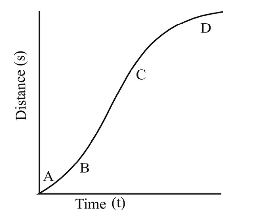Motion in a Straight Line
- A car moving with a speed of 40 km/h can be stopped by applying brakes at least after 2 m. If the same car is moving with a speed of 80 km/h, what is the minimum stopping distance?
-
View Hint View Answer Discuss in Forum
v² – u² = 2as
⇒ a = v² - u² 2s = - u1² , where u1 = 40 km/h 2s
For same retarding force s ∝ u²∵ s2 = u2² ⇒ s2 = 
80 
² = 4 s1 u1² s1 40
∴ s2 = 4s1 = 8m
If F is retarding force and s the stopping distance, then 1/2 mv² = Fs
For same retarding force, s α v²∴ s2 = 
v2 
² = 
80 km/h 
² = 4 s1 v1 40 km/h
∴ s2 = 4s1 = 4 × 2 = 8mCorrect Option: A
v² – u² = 2as
⇒ a = v² - u² 2s = - u1² , where u1 = 40 km/h 2s
For same retarding force s ∝ u²∵ s2 = u2² ⇒ s2 = 
80 
² = 4 s1 u1² s1 40
∴ s2 = 4s1 = 8m
If F is retarding force and s the stopping distance, then 1/2 mv² = Fs
For same retarding force, s α v²∴ s2 = 
v2 
² = 
80 km/h 
² = 4 s1 v1 40 km/h
∴ s2 = 4s1 = 4 × 2 = 8m
-

A particle shows distance - time curve as given in this figure. The maximum instantaneous velocity of the particle is around the point:
-
View Hint View Answer Discuss in Forum
The slope of the graph ds/dt is maximum at C and hence the instantaneous velocity is maximum at C.
Correct Option: B
The slope of the graph ds/dt is maximum at C and hence the instantaneous velocity is maximum at C.
- The displacement x of a particle varies with time t as x = ae−αt + beβt, where a, b, α and β are positive constants. The velocity of the particle will
-
View Hint View Answer Discuss in Forum
Given x = ae–αt + beβt
Velocity, v = dx/dt = –aαe–αt + bβeβt= aα = bβeβt eαt
i.e., go on increasing with time.Correct Option: D
Given x = ae–αt + beβt
Velocity, v = dx/dt = –aαe–αt + bβeβt= aα = bβeβt eαt
i.e., go on increasing with time.
- The displacement of a particle is represented by the following equation :
s = 3t³ + 7t² + 5t + 8where s is in metre and t in second. The acceleration of the particle at t = 1s is
-
View Hint View Answer Discuss in Forum
Displacement
s = 3t3 + 7t2 + 5t +8;
Velocity = ds/dt = 9t² + 14t + 5Acceleration = d²s = 18t + 14 dt2
Acceleration at (t = 1s)
= 18 × 1 + 14 = 18 + 14 = 32 m/s²Correct Option: C
Displacement
s = 3t3 + 7t2 + 5t +8;
Velocity = ds/dt = 9t² + 14t + 5Acceleration = d²s = 18t + 14 dt2
Acceleration at (t = 1s)
= 18 × 1 + 14 = 18 + 14 = 32 m/s²
- A particle moves a distance x in time t according to equation x = (t + 5)–1. The acceleration of particle is proportional to:
-
View Hint View Answer Discuss in Forum
x = 1 t + 5 ∴ v = dx = - 1 dt (t - 5)² ∴ a = d²x = 2 = 2x³ dt² (t - 5)³ Now 1 ∝ v1/2 (t + 5) ∴ 1 ∝ v3/2 ∝ a (t + 5)³
Correct Option: A
x = 1 t + 5 ∴ v = dx = - 1 dt (t - 5)² ∴ a = d²x = 2 = 2x³ dt² (t - 5)³ Now 1 ∝ v1/2 (t + 5) ∴ 1 ∝ v3/2 ∝ a (t + 5)³

